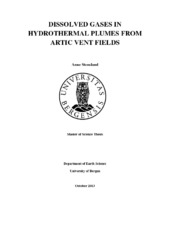| dc.description.abstract | Recent discoveries of active vent fields on slow and ultraslow spreading ridges have revealed that hydrothermal activity is more common than previously assumed. In the Norwegian-Greenland Sea, two such vent fields are found; the Jan Mayen vent fields (71°N and 6°E) and Loki`s Castle (73°30′N and 8°E). Both these systems are located on the ultraslow spreading Mohns Ridge, but they differ profoundly in the geochemical fluid and gas composition. This study presents dissolved hydrogen (H2), methane (CH4) and helium isotope (3He) concentrations in the hydrothermal plume above the two vent fields. The results are based on samples collected during research cruises to the Norwegian Greenland Sea in the period 2007- 2012. The plume at the Loki's Castle rises 400 m from 2400 to 2000 m, and is characterized by considerable amounts of CH4 and H2. The rise- height is thus 50-200 m higher than observed in most hydrothermal fields in the Atlantic and Pacific Oceans. Dilution factors for the buoyant and the non-buoyant plume was calculated to be 1700 and 8900, respectively. The thermal output from Loki's Castle (1300 MW) was estimated to be comparable to that of the Rainbow field due to similar 3He input. Loki's Castle is situated between different ocean current systems, causing extensive mixing and transportation of the plume. Elevated 3He concentrations close to the seafloor indicate either deep water transport from the north or hydrothermal input from the ridge below. Comparison to the deep seawater at the East Pacific Rise, where the spreading rate is 7.5 times faster and the 3He input 6 times larger than at the AMOR, indicating a correlation between spreading rates and the magnitude of hydrothermal activity. Because of background concentrations up to 5 and 7 nM for H2 and CH4, respectively, reliable evidence for hydrothermal input requires values higher than these. Methane anomaly at a depth 2319 m indicate a possible new vent field southwest of Loki's Castle. The non-buoyant plume at the Jan Mayen vent fields (JMVF) was characterized by moderate CH4 and low H2 concentration, and rose 150 m above the Troll Wall and 200 m above the Soria Moria vent field. The dilution factor for the non-buoyant plume was estimated to be 9500 at the Troll Wall vent field. Diffuse venting occurring at the Troll Wall was characterized by the moderate CH4 and very low H2. The CH4 produced here may be of biogenic origin, produced by methanogenesis at or below the seafloor. The H2 content in the water column in 2011 was about 26 times higher than observed in any other year. This excess H2 probably originated from an eruptive event at the seafloor in the JMVF area. The results demonstrate that determination of the dissolved gas composition provides vital information on processes occurring in the surface and subsurface at Artic vent fields. | en_US |
